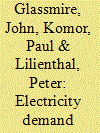|
|
|
Sort Order |
|
|
|
Items / Page
|
|
|
|
|
|
|
| Srl | Item |
| 1 |
ID:
116945


|
|
|
|
|
| Publication |
2012.
|
| Summary/Abstract |
Due largely to recent dramatic cost reductions, photovoltaics (PVs) are poised to make a significant contribution to electricity supply. In particular, distributed applications of PV on rooftops, brownfields, and other similar applications - hold great technical potential. In order for this potential to be realized, however, PV must be "cost-effective"-that is, it must be sufficiently financially appealing to attract large amounts of investment capital.
Electricity costs for most commercial and industrial end-users come in two forms: consumption (kWh) and demand (kW). Although rates vary, for a typical larger commercial or industrial user, demand charges account for about ~40% of total electricity costs. This paper uses a case study of PV on a large university campus to reveal that even very large PV installations will often provide very small demand reductions. As a result, it will be very difficult for PV to demonstrate cost-effectiveness for large commercial customers, even if PV costs continue to drop. If policymakers would like PV to play a significant role in electricity generation - for economic development, carbon reduction, or other reasons - then rate structures will need significant adjustment, or improved distributed storage technologies will be needed.
|
|
|
|
|
|
|
|
|
|
|
|
|
|
|
|
| 2 |
ID:
111410


|
|
|
|
|
| Publication |
2012.
|
| Summary/Abstract |
Over half of U.S. states have renewable portfolio standards (RPSs) mandating that a minimum percentage of electricity sold derives from renewable sources. State RPSs vary widely in how they attempt to control or limit the costs of these RPSs. Approaches utilized include alternative compliance payments, direct rate caps, and cost caps on resource acquisitions, while some states employ no specific limitation at all. This paper describes how states attempt to control RPS costs and discusses the strengths and weaknesses of these various cost controls. There is no one best method; however the experience to date suggests that the most important factors in implementing an effective mechanism to curtail costs are clarity of the rule, consistency in application, and transparency for customers.
|
|
|
|
|
|
|
|
|
|
|
|
|
|
|
|
|
|
|
|
|